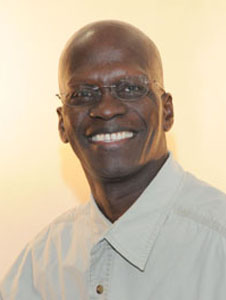Moussa M. Diawara, Ph.D.
Professor Entomology and Toxicology / University Grievance Officer

Degrees
- B.S. in Agricultural Science Engineering (1979), University of Mali
- M.S. in Agronomy/Weed Science (1987), University of Georgia
- Ph.D. in Entomology (1991), University of Georgia
Bio
Positions Held
|
Position |
Institution/Location |
From |
To |
|
University Grievance Officer |
Colorado State University Pueblo |
August 2023 |
Present |
|
Professor, Department of Biology |
Colorado State University Pueblo |
August 2006 |
Present |
|
Colorado Independent Redistricting Commissioner Colorado Independent Redistricting Commissions |
State of Colorado and US Congress |
March 2021 |
Dec 2021 |
|
Chair, Department of Biology |
Colorado State University Pueblo |
May 2016 |
May 2019 |
|
University Grievance Officer |
Colorado State University Pueblo |
May 2011 |
May 2016 |
|
Visiting Scientist |
University of Maryland School of Medicine, Baltimore MD |
August 2003 |
August 2004 |
|
Associate Professor, Department of Biology |
Colorado State University Pueblo |
August 1997
|
August 2002
|
|
Director, Master of Science in Applied Natural Science (MSANS) program |
Colorado State University Pueblo
|
August 1994 |
August 2001 |
|
Collaborator, Center for Toxicology |
University of Arizona, Tucson |
May 1998 |
May 2003 |
|
Collaborator, Center for Toxicology |
Oregon State University |
May 1995 |
May 2001 |
|
Assistant Professor, Department of Biology |
Colorado State University Pueblo |
Aug 1993 |
May 1997 |
|
Director, Fruits and Vegetable Research Center |
Baguineda/Bamako, Mali |
Nov 1981 |
Dec 1984 |
|
Assistant Director, Fruits and Vegetable Research Center |
Baguineda/Bamako, Mali |
June 1980 |
Oct 1981 |
Research Interests
Research Experience
- Professor and Principal Investigator at Colorado State University Pueblo (CSU Pueblo)
- Over $2 million in research grants,
- Over 40 publications in high-visibility scientific journals.
- Environmental health and socio-economic studies, which raised public health concerns due to contamination of residential topsoil by heavy metals, and resulted, in great part, in the $74 million US Environmental Protection Agency (EPA) Superfund remediation process in some neighborhoods of Pueblo, Colorado.
- Clinical trials on the impact of cannabidiol (CBD) on learning and memory.
- Clinical studies on the determination of blood lead (Pb) level of children exposed to environmental heavy metal contamination.
- Member of the CSU Pueblo Institutional Review Board (IRB).
Managerial, Teaching & Mentoring Experiance
- Developed and taught a wide range of upper division courses including environmental toxicology, environmental policy and management, medical and veterinary entomology. Risk assessment, the dose-response relationship, and drug/xenobiotic metabolism are topics discussed in the environmental toxicology class. The environmental policy and management course covers federal regulations. The discussions in the medical and veterinary entomology course include the etiology of vector-borne diseases and principles of epidemiology.
- As University Grievance Officer at CSU Pueblo, I ensure a rapid and fair process for the resolution of grievable conflicts which are not resolved through mediation.
- As former chair of the biology department at CSU Pueblo, I managed the department’s budget and personnel for three years, helped develop the wildlife major, and conducted a program review.
- As former director of the CSU Pueblo Master program in biology, I secured the graduate program, mentored undergraduate and graduate student research projects, including environmental health studies and clinical trials.
Other Activities
Certification
- Institutional Review Board (IRB) Member certification from Collaborative Institutional Training Initiative (CITI)
- IRB Chair certification from CITI
- Advanced Training Clinical Research Coordinator (CRC) certification from Certified Clinical Research Professionals Society (CCRPS)
- Advanced ICH GCP certification from CCPRS
- Mediation certification
Publications
Selected Publications
Diawara, MM., and Greteman, LM., 2025. Successful Superfund Remediation in Pueblo, Colorado: A Provocative Reflection on Community Engagement and Empowerment. Medical Research Archives, [online] 13(6). https://Doi.org/10.18103/mra.v13i6.6679
Diawara, MM. 2025. Pharmacogenetics of Lead Toxicity. Medical Research Archives, [online] 13(1). https://doi.org/10.18103/mra.v13i1.6268
Gebregzi HH, Zeiger JS, Smith JP, Stuyt L, Cullen L, Carsella J, Rogers DC, Lafebre J, Knalfec J, Vargas A, Diawara MM. Oral cannabidiol did not impair learning and memory in healthy adults. J Cannabis Res. 2025 Jan 23;7(1):5. doi: 10.1186/s42238-025-00262-2. PMID: 39849639. https://doi.org/10.1186/s42238-025-00262-2
Peterson EK, Carsella J, Varian-Ramos CW, Schiffer T, Staples SK, Diawara M. Effects of Lead (Pb) from Smelter Operations in an Urban Terrestrial Food Chain at a Colorado Superfund Site. Bull Environ Contam Toxicol 112, 17 (2024). https://doi.org/10.1007/s00128-023-03846-x
Diawara MM, Shrestha S, Carsella J, Farmer S. 2018. Smelting remains a public health risk nearly a century later: a case study in Pueblo, Colorado, USA. International Journal of Environmental Research and Public Health. 15(5), 932. doi: 10.3390/ijerph15050932 https://www.mdpi.com/1660-4601/15/5/932
Diawara MM and Unis D. 2009. Arsenic toxicity to preimplantation stage embryo. In Environmental Health Risks: Lead Poisoning and Arsenic Exposure, JD. Gosselin and IM. Fancher (eds.). Chapter 9. Nova Publishers. Hauppauge, NY.
Unis D, Osborn C, Diawara MM. 2009. Arsenite exposure compromises early embryonic development in the Golden hamster. Reproductive Toxicology 28:329-334 https://pubmed.ncbi.nlm.nih.gov/19447171/
Diawara MM, Litt JS, Alfonso N, Unis D, Martinez LA, Smith DB, Crock JG, Carsella J. 2006. Arsenic, cadmium, lead, and mercury in surface soils, Pueblo, Colorado: Implications for population health risk. Environmental Geochemistry & Health 28:297-315. https://link.springer.com/article/10.1007/s10653-005-9000-6
Dave Unis, Marcos Unis, and Moussa M. Diawara. 2006. Effects of the Coumarin 8-methoxypsoralen on Early Embryonic Development in the Golden Hamster Mesocricetus auratus. Polyphenol Communcations. Eds. F. Daaf et al. University of Manitoba Press, Canada. Pages 463-464.
Jennifer M. Cozzetta, Cassandra L. Osborne, and Moussa M. Diawara. 2006. Toxicity of 8-MOP on the Development of Early Embryos of Xenopus laevis, the African Clawed Frog. Polyphenol Communcations. Eds. F. Daaf et al. University of Manitoba Press, Canada. Pages 113-114.
Cipolla McDermott D, Hoyer PB, and Diawara MM. 2005. 8-methoxypsoralen suppresses production of ovarian aromatase proteins. Journal of Toxicology – Toxins Review 24: 235-245.
